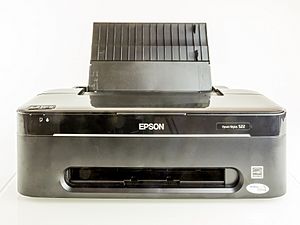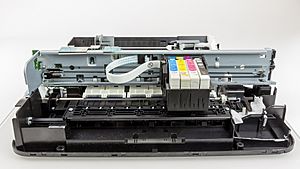Inkjet printer facts for kids
An inkjet printer is a type of computer printer that uses tiny drops of ink to put images and text onto paper. It's different from a Laser printer, which uses powder (called toner) and heat. Inkjet printers are often chosen for printing photos and colorful graphics because they can make really good colors. Laser printers are usually better for printing lots of text because they are faster and make very clear black words.
Inkjet printers are often used by people who don't print very often. The ink comes in special containers called ink cartridges. These cartridges can be quite expensive, and sometimes the ink inside them can dry up if you don't use the printer for a while. If the ink dries, you'll need a new cartridge.
Contents
How Inkjet Printers Use Colors
Most inkjet printers use three main colors of ink: magenta (a pinkish-red), yellow, and cyan (a blue-green). These three colors can be mixed together to create almost any color you see on a screen. There's also a separate black ink cartridge for printing clear black text and dark images. Some professional printers use even more colors, like light cyan, light magenta, blue, red, green, orange, or grey, to make photos look even better.
Types of Ink
Inkjet printers can use two main kinds of ink: dye ink or pigment ink.
- Dye inks are good for making photos look very realistic and are less likely to clog the printer's tiny nozzles.
- Pigment inks are less likely to fade over time, so your prints will last longer.
Printing Big and Saving Ink
Some professionals use very large inkjet printers to print on huge surfaces, sometimes up to 5 meters (about 16 feet) wide! These big printers usually don't use small cartridges. Instead, they have a continuous supply of ink that can last for a long time, which is more economical. You can also find regular-sized printers (for A4 or US Letter paper) that have a continuous ink supply system.
Special Paper for Inkjet Printers
To get the best results, inkjet printers often need special paper. This paper has a coating that helps the ink dry quickly and prevents it from smearing or bleeding, making your prints look sharp and clear.
Cost and What They Can Print
You can find inkjet printers that cost just over 100 US dollars. They are a good deal if you want to print in color without spending too much on the printer itself. However, remember that the ink cartridges can be quite expensive over time. Some advanced inkjet printers can print on things other than paper, like CDs, DVDs, or even plastic cards.
Print Quality: DPI
The quality of an inkjet print is measured in DPI, which stands for "Dots Per Inch." This tells you how many tiny ink dots the printer can place in one inch of paper.
- Older inkjet printers might print at 300 to 720 DPI.
- Newer printers can print at much higher resolutions.
Even though printers can print at very high DPI, your eyes might not notice the difference beyond about 720 DPI.
Common Problems and How to Fix Them
A common issue with inkjet printers is when the printhead gets clogged. The printhead has tiny nozzles that spray the ink. If these nozzles get blocked, you might see "banding" (light or dark stripes) across your printed images.
- How to fix it: Most printers come with software that has a cleaning function. Running this cleaning cycle can help clear the clogged nozzles.
- When it happens: This problem happens most often when the printer hasn't been used for a long time.
- How to prevent it: If you don't use your printer often, you can set up a special program (sometimes called a cron job) to print a "purge sheet" once a day. This sheet uses all the colors and helps keep the nozzles from drying out and getting clogged. Even with a perfectly clean printhead, you might see a tiny bit of banding that's usually only noticeable if you look very closely with a magnifying glass.
More Pictures
-
A Canon inkjet printer with its CMYK ink cartridges
-
Inkjet heads: a disposable head (left) and a fixed head (right) with an ink cartridge (middle)
-
Air vent tubes on top of an Epson Stylus Photo 5-color ink tank. These long air channels are molded into the tank, and a blue label seals them into tubes. The yellow label is removed before use, opening the tubes to the air so ink can spray out. Removing the blue label would break the tubes and cause the ink to dry out quickly.
-
Tiny printed circuit boards (microchips) from Epson ink cartridges. A black epoxy covers the chip itself.
See also
 In Spanish: Inyección de tinta para niños
In Spanish: Inyección de tinta para niños















